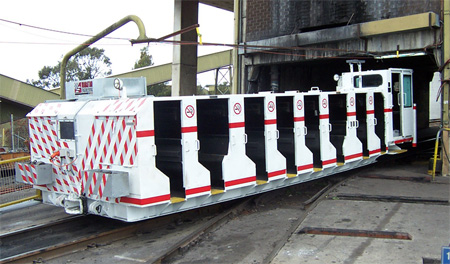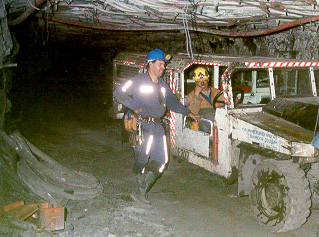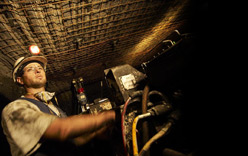Personnel Transport
Where access to a mine is by a drift or inclined shaft
and rail is installed, personnel transport typically utilises a vehicle
permanently attached to a winding rope with provision for seating passengers. Again
this vehicle is typically used as a means of attaching other rolling stock to
the winding rope and, whether set-up to carry passengers or not is usually referred
to as a "dolly car". A
dolly car can be automatic (push button control by the passenger) or operated
by an on board operator, particularly where the dolly car is utilized to haul
other rolling stock into and out of the mine.
Dolly cars typically have limited capacity for
passengers and additional personnel carriage(s) are attached at shift
changeovers to enable the full shift to be transported in one load or lift.

Dolly car fitted for man riding as well as connecting to materials transport cars;
drivers cabin at rear; radio control via overhead aerial
For vertical shafts, personnel transport may be in a
large shaft vehicle, or "cage" with the cage being used to transport materials at other times, or may
be in a special permanent personnel winder which operates more like a building
lift. Most shaft conveyances are fully automated, requiring only a start button
to be pressed.
There may be benefits in separating personnel and material
transport systems, particularly in relation to the greater efficiency then
possible of material transport. With shared systems, it is normal to suspend
material transport in the event that passengers are to be conveyed in the
system. Such suspensions can be extremely disruptive, particularly in large
mines where the material transport system is fully utilized.
With rubber tyred systems various types of personnel
transports have been developed to fit in with the materials transport (e.g,
trailers or pods fitted out for personnel transport but handled by the normal
materials handling prime movers). There have also been convertible vehicles
developed where seating for personnel could be folded away leaving the vehicle
suitable for materials. Most of these vehicles operated successfully, but
interference with the materials transport system when personnel transport was
required led to inefficiency, especially if some personnel transport was
required for the full shift.
 Purpose designed vehicles are now typically used for
personnel transport such vehicles essentially being modified "landcruisers" or
"troop carriers". These vehicles offer considerable flexibility as they can be
used throughout the shift to carry staff, inspection personnel, tradesmen, etc
who do not work in a single location and can also be quickly adapted for use as
an ambulance if required. The development of the landcruiser style vehicles
with improved seating and ergonomics has generally led to the demise of other
types. Though several of these older vehicles are still in use they are
generally being replaced by the landcruiser type when the reach the end of
their economic life, if not before..
Purpose designed vehicles are now typically used for
personnel transport such vehicles essentially being modified "landcruisers" or
"troop carriers". These vehicles offer considerable flexibility as they can be
used throughout the shift to carry staff, inspection personnel, tradesmen, etc
who do not work in a single location and can also be quickly adapted for use as
an ambulance if required. The development of the landcruiser style vehicles
with improved seating and ergonomics has generally led to the demise of other
types. Though several of these older vehicles are still in use they are
generally being replaced by the landcruiser type when the reach the end of
their economic life, if not before..
Many mines also utilize multi-purpose vehicles which
can carry a limited number of people as well as materials (e.g. utility
vehicles to carry tradesmen and equipment, special pipe handling vehicles,
etc).
A recent development in personnel transport is the use
of "non flameproof" vehicles for personnel transport in restricted areas (being
intake airways). Their use in areas likely to contain gas (hazardous zones) is
prevented at least by mine rules but also by attaching automatic cut-out
devices operated by a radio signal from devices attached to the roadway ribs or
roof. Such vehicles are much cheaper to purchase and maintain, essentially
being standard off road vehicles.
It should be noted that some mines also utilise
bicycles for individual transport. Provided road surfaces are in good condition
they have been quite popular with mine personnel, particularly supervisors and
specialist staff. However some mines have discontinued their use due to
perceived safety concerns (it is quite easy to fall off, though the writer is
unaware of any serious injuries having been suffered).

